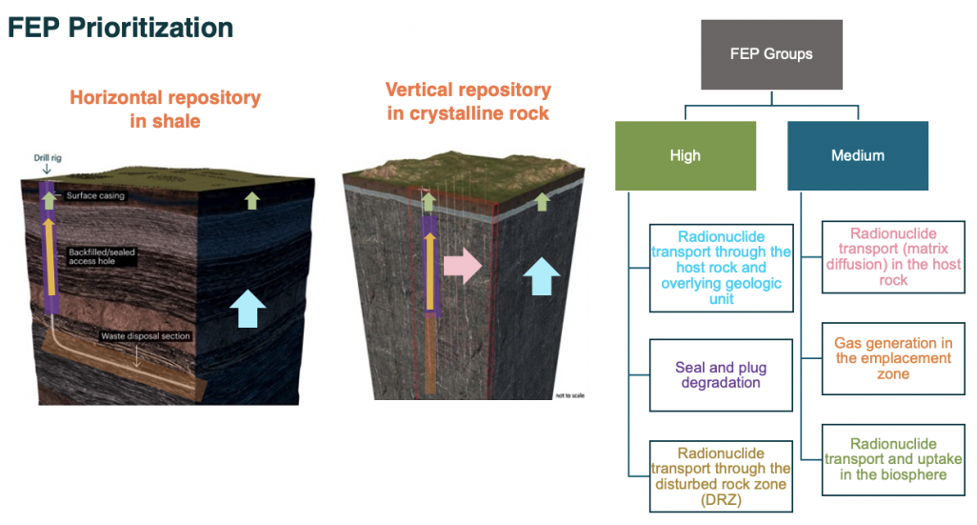By Dr. Ethan Bates
Deep Isolation Director of Systems Engineering Dr. Ethan Bates presented his paper, co-authored with borehole sciences expert John Midgley, titled Features, Events, and Processes Prioritization for Deep Borehole Disposal Concepts in Crystalline Rock and Shale, at the American Nuclear Society Meeting in Anaheim, Calif., earlier this month.
We sat down with Dr. Bates to learn more about these analyses.
Q: What are FEPs? Why are they relevant to the safety analysis of nuclear waste disposal?
FEPs stands for “features, events, and processes” and studying this allows us to categorize phenomena affecting nuclear waste repository performance. Specifically, events and processes impact the features of the repository, and a screening process is needed to evaluate which of these is important to safety in the long run. This paper generally addresses FEPs for borehole concepts that Deep Isolation (and other institutions) are considering and prioritizes a subset of FEP groups to guide future collaborations. This is to support the safety and feasibility evaluation of deep borehole concepts in a wider range of geologies, including crystalline rock and shale.
Q: What was your motivation for prioritizing features, events, and processes in deep borehole disposal concepts in crystalline rock and shale?
Modern drilling technologies broaden our options for nuclear waste disposal to a wider range of sites, geological environments, depths, and configurations. In the past, researchers (including myself) focused on crystalline rock as the host rock, but Deep Isolation has shown that equally safe repositories could be constructed in shale using horizontal drilling. This option could be very helpful in the siting process (which can be challenging) but it increases the scope of work required in the early stages of designing borehole repositories.
To perform a comprehensive evaluation of the safety of a deep borehole repository, we need to analyze all the phenomena, initiating events, and boundary conditions affecting deep borehole repositories over 10,000 years or more. With limited resources, it’s important to focus our efforts on the FEPs that are assessed to be of greater importance.

Q: What are the high-priority FEPs, and how were they determined?
To streamline the prioritization process, a smaller subset of FEP groups was created. Then, an expert panel (including those from a leading national laboratory) was convened to assess the relative importance of the FEP groups. The FEP group related to radionuclide transport through the host rock barrier, which varies with depth, was deemed high-priority because in the deep borehole disposal concept this barrier strongly impacts the safety of the repository. Ultimately, three high-priority FEP groups were identified:
- radionuclide transport through the host rock and overlying geologic units;
- seal and plug degradation; and
- radionuclide transport through the disturbed rock zone.
Further evaluation of these FEPs will advance the generic feasibility and safety assessment of deep borehole disposal concepts.
Q: What are the big takeaways from this work?
Early findings on the high priority FEP group related to host rock transport properties show that deep borehole disposal enables wider access to host rocks where diffusion of radionuclides (extremely slow and predictable, relative to advection) is the dominant transport mechanism. Imagine having a sugar cube at the bottom of a glass of water: With diffusion, the water is not moving and it takes a very long time for the sugar to dissolve into the water. Having advection is equivalent to stirring the glass and allows for much more rapid transport of the sugar.
Q: What are the next steps?
High- and medium-priority FEPs were identified in this paper to better understand the long-term performance assessment of deep boreholes for nuclear waste disposal. Although a preliminary analysis was conducted on the high-priority FEP group related to host rock properties, additional work is needed to draw general correlations about the depth variation of clay properties. Future work on the other high priority FEP groups such as transport through the disturbed rock zone and seal and plug degradation might eventually show these FEPs to have a lower significance in the safety case than initially thought, for example, by showing that the repository performs safely even when these features and barriers are conservatively assumed to be degraded. Additional efforts will also go toward the medium priority FEPs such as gas generation in the emplacement zone, transport and dilution in the biosphere, and matrix diffusion, which can act as an important delay mechanism in crystalline rock.
Related posts
*Deep Borehole Expert Joins Deep Isolation
*Sealing of a Deep Horizontal Borehole Repository for Nuclear Waste
